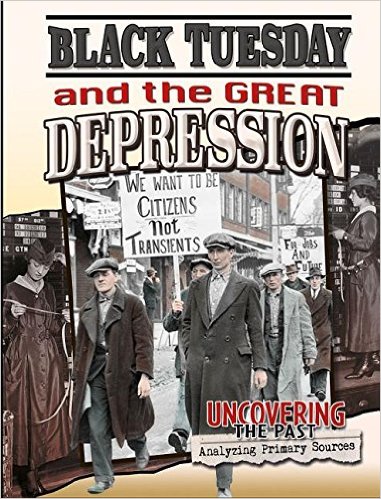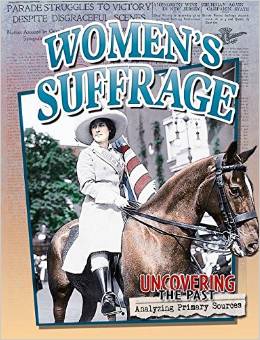| ________________
CM . . .
. Volume XXII Number 12. . . .November 20, 2015
excerpt:
The two latest books in the “Uncovering the Past: Analyzing Primary Sources” series, Black Tuesday and the Great Depression and Women's Suffrage, maintain the quality of the previous books in the series. I have never seen books written for elementary students that so clearly explain and illustrate both how to evaluate sources of information, and why we need to think critically about the sources we are using. Normally I wouldn't quote from the promotional material from a publisher, but I totally agree with this summation on the back cover of these books.
The series, “Uncovering the Past: Analyzing Primary Sources”, uses eye-witness accounts, photographs, art work, illustrations, and newspaper reports, as well as songs of the period, to teach students how to think critically about their sources of information. Each book ends with a look at a present-day example of similar events as evidence, sadly, that history does repeat. Identifying bias, prejudice, and perspective, and learning to examine more than one source of information are critical skills for students of the information age. Most importantly, the critical thinking and evaluating skills taught by looking at the records from the past are highly transferable to other research topics. Each book in the series begins with an introduction to the historic topic of the book, giving a context to the documents and artifacts that will be presented as source material. The initial chapter in each book also presents an explanation for why we need to learn about the past. The books then look at different types of evidence, giving examples of types of primary source material and the distinction between primary and secondary source material. Black Tuesday and the Great Depression and Women's Suffrage both emphasize the importance of examining the context surrounding even primary source material.
Women's Suffrage explains that “[some] primary sources are considered better than others.” )
The final chapter in each book looks at a modern day example of the historical content of the book. In Women's Suffrage, the chapter “Influencing the World: History Repeated” examines the modern feminist movement and worldwide campaigns for human rights and an end to violence against women.
Each book includes a table of contents, a timeline of events which includes a map, a bibliography including quotation references, a glossary and an index. Also included in each book are “Internet Guidelines” with questions such as, “Who writes and/or sponsors the page? Is it an expert in the field, a person who experienced the event, or just a person with an opinion?” That feature alone makes these books invaluable. Black Tuesday and the Great Depression uses newspaper clippings and photographs from the time to examine the record of the lead up to and effects of the Great Depression. Because the Great Depression started in the United States, the majority of the events in the book occur in the US, but the effects of the Great Depression spread far beyond the US. References to what was happening in Canada and around the world are included. Women’s Suffrage contains specifics about the Canadian experience, including information about the Famous Five and the Person’s Case. Like the previous books in the “Uncovering the Past: Analyzing Primary Sources” series, both Black Tuesday and The Great Depression and Women’s Suffrage will be important resources to help students improve their skills in examining evidence critically for bias and reliability. I highly recommend both of these books. Highly Recommended. Suzanne Pierson, a retired teacher-librarian, is currently instructing Librarianship courses at Queen’s University in Kingston, ON.
To comment
on this title or this review, send mail to cm@umanitoba.ca.
Copyright © the Manitoba Library Association. Reproduction for personal
use is permitted only if this copyright notice is maintained. Any
other reproduction is prohibited without permission.
Next Review |
Table of Contents for This Issue
- November 20, 2015. |

